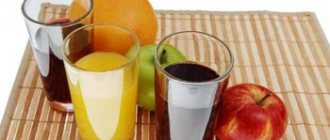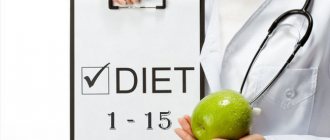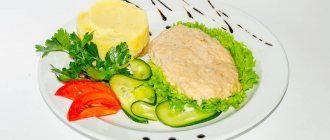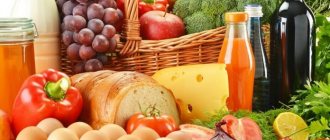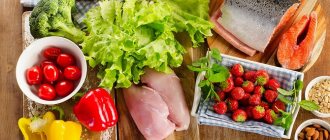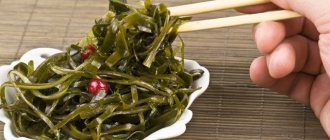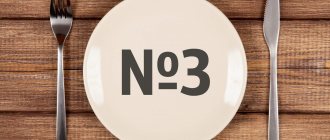“Table No. 5” is a special therapeutic diet developed in the 20-30s of the twentieth century by the founder of Russian dietetics, Manuil Pevzner. It is considered one of the best diets for people suffering from diseases of the liver, biliary tract and gall bladder. In this article we will analyze the basic principles of diet No. 5 and consider an approximate menu for this diet.
The general principles of therapeutic diets, including diet number 5, are: a balance of basic nutrients (proteins, fats and carbohydrates), a fractional diet, reducing the amount of table salt and refractory fats, abundant fluid intake and gentle cooking methods - boiling, steaming, baking. That is, the principles of proper nutrition that are familiar to all of us.
“Table No. 5”: diet and daily diet.
The content of the article:
One of the most important principles of this diet is fractional nutrition. “The best remedy to counteract stagnation of bile is frequent meals... every 3-4 hours,” wrote M. I. Pevzner. As for the energy value, “Table No. 5” is a complete diet (2500-2900 kcal per day) with an optimal content of proteins, fats and carbohydrates, with the exception of foods rich in purines, nitrogenous extractives and cholesterol, oxalic acid, essential oils, fat oxidation products formed during the frying process.
The diet is enriched with lipotropic substances (lean meat and fish, egg whites, low-fat cottage cheese), pectins (for example, apples), and also contains a significant amount of fiber and liquid.
The amount of protein in the diet should correspond to the physiological norm: 1 g per 1 kg of ideal body weight, of which 50-55% should be proteins of animal origin (meat, fish, poultry, eggs, dairy products).
The recommended amount of fat is 70-80 g. Animal fats should be 2/3, vegetable fats should be 1/3 of the total amount. The best animal fat to use is butter - it is easily digestible and contains vitamins A, K, and arachidonic acid. But the amount of refractory fats (lamb, pork, beef) must be limited: they are difficult to digest, contain a lot of cholesterol and saturated fatty acids, and can contribute to the formation of cholesterol stones and the development of fatty liver. As for the amount of carbohydrates in the diet for patients with diseases of the liver and biliary tract, it has been revised several times. Initially, the “Table 5” diet contained 300-350 g of carbohydrates, of which 60-70 g were simple. Later, the amount of carbohydrates was reduced at the expense of simple ones (300-330 g in total, simple ones - 30-40 g).
Currently, Pevzner tables are not used in medical institutions: according to order No. 330, since 2003 in Russia, instead of a numbered one, a numberless system of treatment tables in hospitals has been introduced - it includes 6 options for standard diets
Protein omelet with vegetables
Ingredients:
- White cabbage – 30 gr.
- Zucchini – 30 gr.
- Carrots – 30 gr.
- Parsley – 5 gr.
- Milk – 50 gr.
- Butter – 10 gr.
- Egg whites – 2 pcs.
- Sour cream 10 or 15% – 10 gr.
Cooking method:
Chop cabbage and zucchini, grate carrots on a coarse grater. Place the vegetables in a saucepan and simmer in milk and butter until tender. Beat egg whites, mix with milk, pour over vegetables and sprinkle with herbs. Bake in the oven, first brushed with sour cream.
Products that CAN be consumed while on a diet.
Beverages:
Weak tea with lemon, semi-sweet or with a sugar substitute (xylitol), milk; rosehip decoction; fruit and berry juices without sugar, pureed compotes from fresh and dry fruits; jelly; mousses with a sugar substitute (xylitol) or semi-sweet with sugar.
Soups:
Vegetarian - with water or vegetable broth, mashed with potatoes, zucchini, pumpkin, carrots, semolina, oatmeal or buckwheat, rice, noodles. It is allowed to add 5 g of butter or 10 g of sour cream. Fruit soups; milk soups with pasta; borscht (without broth); vegetarian cabbage soup; beetroot; pea soup. Attention! No sauteing! Flour and vegetables for dressing are not fried, but dried.
Meat/fish/seafood:
Lean beef, veal, rabbit, chicken, turkey (all poultry without skin). Only boiled or steamed, pureed or chopped (cutlets, soufflé, puree, dumplings, beef stroganoff, soft meat in pieces); cabbage rolls, milk sausages (very limited); low-fat fish (pike perch, cod, hake, pollock, tuna), fresh oysters; shrimp, squid, mussels - limited; lightly salted salmon, salmon - limited in fat content and as a snack, not a main course; dumplings with veal or chicken (dough, lean meat, water, salt) - very limited in fat content and definitely (!) - not fried.
Ideal lunch - steamed cabbage rolls with lean minced meat
Porridge:
Pureed and semi-viscous from buckwheat, oatmeal, semolina, as well as rice, boiled in water or half and half with milk; various products from cereals - soufflés, casseroles, puddings half and half with cottage cheese, casseroles from noodles, cottage cheese; pilaf with dried fruits; muesli (without additives prohibited in the diet), oatmeal (without additives).
Bread:
Bran; rye; wheat from flour of the 1st and 2nd grades, dried or yesterday's baking, crackers; unsweetened dry biscuits, biscuits; baked goods with boiled meat and fish, cottage cheese, apples; dry biscuit.
Fermented milk/milk products:
Sour cream and cheese (not too spicy and in very limited quantities); no more than 2% fat content kefir, yogurt and half-fat or low-fat cottage cheese, milk - 200 g. You can also have cottage cheese dishes, soufflés and casseroles, lazy dumplings and cheesecakes, curdled milk, puddings.
Vegetables:
Starchy vegetables, boiled and baked in pureed form: potatoes, cauliflower, carrots, zucchini, pumpkin, beets, green peas, Chinese cabbage; salads (romaine, corn, iceberg and other salads neutral in taste) in limited quantities; bell peppers, seaweed, cucumbers, tomatoes (in very limited quantities; in case of exacerbation, it is advisable to exclude them).
Steamed chicken cutlets with mashed potatoes fit perfectly into the diet menu “Table No. 5”
Fruits:
Ripe, soft and non-acidic apples (mashed raw or baked); 1 banana per day, pureed compotes from fresh and dry fruits, jellies and mousses with sweeteners; prunes, 2 small pieces of watermelon.
Eggs:
In the form of protein omelettes - up to two whites per day, no more than ½ yolks in dishes;
Fats:
Butter (up to 30 g); refined vegetable oils (up to 10–15 g) added to dishes.
Sauces and seasonings:
Vegetable non-spicy sauces, milk sauces and sour cream; fruit dips. Salt on diet number 5 is limited - no more than 10 grams per day (!); soy sauce.
Sweet:
Marshmallows in very limited quantities; marmalade and sweets without cocoa and chocolate; jam (not sour and not very sweet and is best dissolved in light tea or hot water), marshmallow, honey; sugar in small quantities.
On diet number 5 you can sometimes eat marshmallows
Carrot zrazy with apples
- Carrots – 125 gr.
- Eggs – 1 pc.
- Milk – 1 tbsp. l.
- Apples – 60 gr.
- Semolina – 1.5 tsp.
- Flour – 1 tsp.
- Sugar – 1 tsp.
Cooking method:
Place carrots, grated on a coarse grater, in a frying pan, add milk, cover with a lid and simmer until almost done. Then pour in semolina in a thin stream, followed by sugar. Stir the mixture and boil.
Cool the mass, add the egg, knead again. Divide the finished carrot dough into small flat cakes, into which we place and wrap apples grated on a coarse grater and sprinkled with sugar (without the seeds and peel).
Roll the cakes in flour, place on the prepared baking sheet and bake for 20 minutes.
Foods that CANNOT be consumed while on a diet.
Beverages:
Coffee, cocoa; carbonated and cold drinks, grape juice, Alcoholic drinks (all are strictly prohibited, including low-alcohol ones).
Soups:
Broths cooked with meat, fish and mushrooms, as well as broths based on legumes, sorrel or spinach; okroshka in any form.
Porridge:
Legumes are excluded; pearl barley, barley, corn grits, limited to millet.
Pasta:
Fatty pastes; pasta with ingredients prohibited in the diet, as well as with spicy, creamy or tomato sauces.
Meat/fish/seafood:
Kidneys, liver, tongue, all sausages, smoked products, as well as canned meat; cooking fats, along with beef and lamb, are completely excluded; canned fish, salted and smoked fish, fatty fish (salmon, trout, carp, eel, sturgeon, stellate sturgeon, beluga, catfish, etc.), granular caviar (red, black), sushi.
Bread:
All products made from puff pastry and pastry; fried donuts; fresh bread; pancakes; fried pies.
Fermented milk/milk products:
You should not eat salted cheeses; fatty dairy products; cream, milk 6%, fermented baked milk, full-fat cottage cheese.
Vegetables and fruits:
Mushrooms, corn, sorrel, spinach and rhubarb, radishes, turnips, eggplants, garlic, onions, asparagus, cooked sweet peppers; green onions, pickled vegetables, canned foods, including canned peas; salads and herbs that are bitter, sour, spicy (parsley, dill, spinach, chicory, arugula, frisee, etc.) cannot be used as a main component or main dish. Almost all raw fruits and berries, including sweet fruits (for example, figs and raspberries), as well as cranberries, lingonberries, grapes, dates, kiwis, oranges, tangerines, pears, persimmons, melons, pumpkin seeds, etc.
You can have pumpkin soup on the “Table No. 5” diet, but you shouldn’t sprinkle it with seeds when serving
Eggs:
Hard-boiled, fried, whole egg dishes.
Fats:
Pork, beef, lamb lard, cooking fats.
Sauces and seasonings:
Mayonnaise; ketchup; mustard, horseradish, pepper; vinegar; adjika; any spices.
Sweet:
Chocolate and cream products, ice cream; halva; any fatty desserts and confectionery products with cream.
Carrot-curd casserole
Ingredients:
- Carrots – 140 gr.
- Cottage cheese – 9% 50 gr.
- Semolina – 10 gr.
- Milk – 20 gr.
- Sugar – 5 gr.
- Sour cream – 20 gr.
Cooking method:
Place the carrots cut into small pieces in a saucepan, pour in the milk and place on low heat. Bring to a soft state, cool and grind the vegetable in a meat grinder.
Cook thick semolina porridge: take about 10 g of cereal for 60 g of boiling water. Cook the porridge with continuous stirring for approximately 10 minutes.
Mix the carrot mass with prepared semolina, pre-grated cottage cheese and sugar. Place the resulting mixture on a greased baking sheet. Coat the dough with sour cream on top and bake for 30-40 minutes.
“Table No. 5”: sample menu
Based on the basic principles of a therapeutic diet, as well as from the list of permitted and prohibited foods, diet table menu number 5 could be something like this:
Breakfast: a white omelette of two eggs, a couple of crackers or biscuits, a little butter and tea with lemon. Second breakfast: lazy dumplings. Lunch: vegetarian cabbage soup, steamed chicken cutlets, dried fruit compote. Afternoon snack: apples. Dinner: boiled hake with mashed potatoes and vegetable salad. Before bed: kefir or low-fat cottage cheese.
Omelette in a mug
Ingredients:
- Chicken egg – 1 pc.
- Egg white – 1 pc.
- Milk or water – 1-2 tbsp. l
- Salt - on the tip of a knife (optional)
Preparation:
This omelet is incredibly easy to prepare. It’s just important to understand that everyone’s microwave is different. Once you've cooked it a couple of times, you'll get the hang of exactly how much time you need. But the whole process will definitely not take more than 5 minutes.
Beat the whole egg and white with milk or water. Pour into a deep plate or mug and put in the microwave. If you are preparing an omelette this way, turn off the heat every 20-30 seconds and stir the dish. And when you get used to it, it will be enough to do it once in the middle of cooking.
Mozzarella – 160-280 kcal, fat content – from 17 to 24%, proteins – 28 g
Italian mozzarella, purely formally, is in fourth place in our ranking. In fact, it shares the same position with feta, since its fat content can reach the same 24%. But if you try, you can find a more dietary product with 17% fat content.
What's good about mozzarella? This young, tender cheese goes well with almost all vegetables, herbs and even berries. Like any natural cheese, mozzarella is rich in phosphorus and calcium, contains easily digestible protein and healthy fatty acids. However, it is worth noting that mozzarella is not a source of beneficial lactic acid bacteria: milk for it is fermented using rennet enzymes, without additional microflora.
! Natural mozzarella has a very short shelf life - 5-7 days.
If the label indicates an expiration date of more than a week, preservatives have definitely been added to such mozzarella.
Feta – 290 kcal, fat content – 24%, proteins – 17 g
Let's start from the end: the top five low-fat cheeses is closed by feta - the one without which it is impossible to imagine a Greek salad. The fat content of feta can reach up to 50%; we are satisfied with the option with 24%.
Let me make a reservation right away: table No. 5 does not allow overtly salty cheeses, like feta cheese. Feta, although stored in brine, is tender in taste. Therefore, there is no strict ban on it.
Feta takes a lot from sheep's milk, which is its base. This cheese is rich in beta-carotene and vitamins A, E, K, D, group B, phosphorus, potassium, magnesium, iron, manganese, selenium, but most of all it contains calcium and sodium.
There are so many beneficial lactic acid bacteria in feta that they are quite enough to eliminate gastrointestinal disorders, including those caused by food poisoning. True, only feta made from natural and unpasteurized sheep’s milk has such properties.
Adyghe cheese – 240 kcal, fat content – 14%, proteins – 19 g
Next in line is Adyghe cheese. In my opinion, this is an ideal option for breakfast. The previous two options are more likely associated with afternoon tea or five o'clock tea - this is more of a light snack. It’s easy to start your day with Adyghe. It, unlike mozzarella, is produced by introducing lactic acid bacteria into pasteurized milk. At the same time, the taste is almost the same as its Italian counterpart.
Adyghe cheese is an integral part of the diet not only of patients following diet No. 5, but also of everyone losing weight. It contains only 14% fat, 19 grams of protein and no carbohydrates at all.


